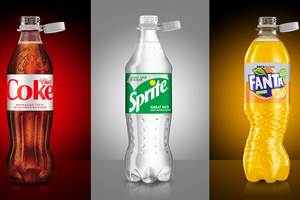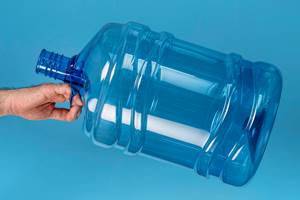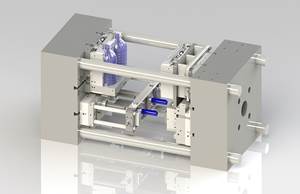BLOW MOLDING: Single- or Two-Stage PET Bottle Making: Get to Know Your Options
The decision which process to use can be quite complex. Here are pointers that will help you to choose the right one for your application
Production of PET containers requires injection molding of preforms and subsequent stretching and blowing of these into bottles. Both operations can be combined in one machine (the single-stage process) or in two (the two-stage process). Both processes have their distinct advantages and disadvantages, and bottle producers and brand owners would be well advised to know those in order to make the right choice for their products.
The advantages of single stage are:
• Blemish-free bottles;
• Transfer ring not necessary;
• Control over preform production;
• Good conditioning possibilities for oblong bottles on
some machines;
• Thread start can be chosen to coincide with bottle shape;
• Compact and flexible.
In my view, these advantages makes this process a no-brainer for all non-beverage containers. However, there are some disadvantages as well, including:
• Long cycle times;
• Long changeover times;
• Uneven wall distribution;
• Quality problems with thermal-gated hot runners (valve gates
are available and recommended);
• Need to run machines run 24 hr/day to avoid higher scrap percentage;
• Longer learning curve for operators, as two processes and PET drying must be mastered;
• Inefficient blow station as the injection station always has precedent over the cycle time.
The latter issue has led to a subcategory of single-stage machines that I call integrated two-stage machines. These machines feature a multiple of two or three injection cavities per blow cavity, and the blow sections of them cycle two or three times for every injection cycle. This saves blow cavities and thereby reduces tooling costs, a critical issue for small- and medium-volume applications.
The uneven wall distribution is a result of viscous heating of the melt. As the melt moves through the barrel and hot-runner channels it heats up unevenly. When it is then divided into two streams (left and right, typically), warmer material flows to the back of the new channel. If you were to stand in front of the machine you might notice that finished bottles are often thinner at the back because they were blown with warmer material in the back panel.
While PET is very good at self-leveling (the strain-hardening effect that compels initially warmer areas to blow out after cooler areas have blown), this effect is not significant enough to mask the uneven preform heat. A variety of measures have been employed over the years with varying success.
Most hot runners are also not naturally balanced. Natural balance means that the path of the melt to each cavity has the same length and number of turns. Because of geometry—all preforms in one row—this is often not possible, and as a result, preforms do not fill at the same speed, aggravating the problem. Changing nozzle diameters to allow slower-moving melt through larger openings is helpful, but usually can only be optimized for a very narrow weight range. Another solution is to add obstacles in the flow path of the faster-moving cavities.
Thermal-gated hot runners are inferior to valve-gated ones, in my opinion, but most machines still run with the former.
Now let’s look at the advantages of the two-stage process:
• Scalable from 1000 to 72,000 bottles/hr;
• Fast cycle times;
• Fast changeovers;
• Flexibility (preforms can be made elsewhere and stored);
• Very good wall distribution for
round bottles;
• On average, lower gram weights possible for round bottles;
• Process can be stopped at any time.
With two-stage, the main disadvantage is the potential damage to the preforms that occurs when they tumble onto conveyor belts and into storage containers, and then again when they are dumped into the hoppers of blow molding machines. Many of the little nicks and scratches can be stretched out when high stretch ratios are used. But this is not always the case, particularly when a preform is chosen from a vendor and does not exactly fit the bottle to be blown. Wrap-around labels or sleeves are a good way to hide these marks, which is one reason they are so popular nowadays.
A lesser known problem with low-cavitation machines is that heat to each preform can be quite different when indexing machines are used. In these machines, two, four, or six preforms are loaded and blown together. A chain indexes them around the oven system.
Preforms are exposed to varying temperatures inside the ovens because of differences in lamp output and exposure to cooling air. This translates into different preform temperatures from cavity to cavity, and adjusting a process to suit them all can be quite a challenge. There are now a number of linear machines available that move preforms continuously and avoid most of these issues. Rotary machines of course do not have this problem at all, as each preform gets identical heat.
Today, more than 80% of all bottles produced are for beverages, and the vast majority of these are made using two-stage technology. It is the remaining 15% to 20% where either process is an option. Many decisions are actually driven by tool prices. Buying even a four-cavity single-stage tool can be hard to justify for volumes of fewer than 2 million/year, which many of the custom applications are. There is less capital expense involved to buy preforms and run them on a two-cavity reheat machine. The number of available preforms has increased dramatically over the last 10 years with suppliers spanning the globe, because preforms, unlike bottles, are cost-effective to ship.
In order to make an informed choice on which process to use, you need to understand the particulars of the application and make your decision either on the basis of bottle features or economics. If your bottle must be blemish-free, oblong in shape, and with a fixed thread, single-stage is the way to go. If none of those applies, the economics must be scrutinized. The preforms for single-stage are always custom-made (unless you plan to make a variety of shapes out of the same preform) so the fit is guaranteed. If preforms are bought however, the quest for the right one starts. Not every preform that has the right neck finish and weight is suitable for a particular bottle. An expert should evaluate the available preforms and choose the best fit.
Let’s look at a hypothetical application involving a round 1-liter bottle with a 33-mm neck finish and a weight of 42 g. The yearly volume in this scenario is 750,000 bottles. In two-stage, this will require a one- or two-cavity machine that will probably run around 600 to 800 bottles/cavity/hr. While machine builders publish much higher numbers, most custom applications run slower for a number of reasons. This will keep the one-cavity machine busy for 1152 hr, and the two-cavity for half of that. Capital cost is quite low as only one or two blow cavities have to be purchased.
In single-stage, cycle time will be about 13 to 16 sec—say 250 cycles/hr. A two-cavity system would then make the required bottles in 1500 hr, a four-cavity system in 750 hr. Capital cost is significant for each cavity, and of course, most machines will be able to run four or even six cavities. Here the decision would be based on cost per piece in different cavitations, and what future outlook the job holds.
Related Content
Coca-Cola Europacific Transitions to Tethered Caps and Lighter PET Bottle
Sidel is converting all Coca-Cola PET bottling lines in Europe to meet new EU packaging regulations by July 2024.
Read MoreStretching the Boundaries of Large PET Containers
NPE2024: Cypet shows off new capabilities for its ISBM machines.
Read MoreAll-Electric Shuttle and Stretch-Blow Machines
NPE2024: Meccanoplastica shows off a double-sided shuttle for containers up to 5 L and a reheat stretch-blow molder for up to 2.5 L PET containers with four cavities — both all-electric.
Read MoreAt NPE, Cypet to Show Latest Achievements in Large PET Containers
Maker of one-stage ISBM machines will show off new sizes and styles of handled and stackable PET containers, including novel interlocking products.
Read MoreRead Next
Making the Circular Economy a Reality
Driven by brand owner demands and new worldwide legislation, the entire supply chain is working toward the shift to circularity, with some evidence the circular economy has already begun.
Read MoreLead the Conversation, Change the Conversation
Coverage of single-use plastics can be both misleading and demoralizing. Here are 10 tips for changing the perception of the plastics industry at your company and in your community.
Read MorePeople 4.0 – How to Get Buy-In from Your Staff for Industry 4.0 Systems
Implementing a production monitoring system as the foundation of a ‘smart factory’ is about integrating people with new technology as much as it is about integrating machines and computers. Here are tips from a company that has gone through the process.
Read More


























